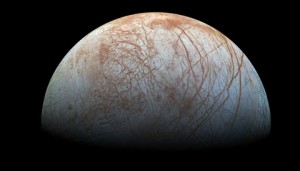A newly processed image from NASA’s Galileo spacecraft shows Europa’s breathtaking beauty and tortured surface in greater detail than ever before.

NASA / JPL / SETI Institute
A close look at the icy surface of Jupiter’s moon Europa reveals a stunning landscape, where long, curving and linear cracks crisscross the surface, interrupted by regions of jumbled terrain.
Color variations across the spattered surface are associated with different geological features: bright white patches contain relatively pure water ice from crater ejecta, red or brown areas show where briny water carrying unknown compounds has been squeezed to the surface, and turquoise regions are relatively old icy plains.
Researchers are eager to learn more about how these markings hint at the geological history of Europa, and the chemistry of the global ocean that exists an estimated 100 km (60 miles) beneath its icy exterior.
So they produced a new version of what is perhaps NASA’s best view of Europa yet. Although the composite’s near-infrared, green, and violet images were obtained in the late 1990s by NASA’s Galileo spacecraft, the original mosaic had lower resolution and strongly enhanced color. This is the first time that the scene has been reproduced using modern image-processing techniques.
And it’s truly a marvel.
Will we ever get a chance to explore Europa more intensively for hints of what its hidden ocean might contain? You bet! Officials for the European Space Agency have just approved taking their Jupiter Icy Moons Explorer mission to the next phase of development. Planned for launch in 2022 and arrival at Jupiter in 2030, JUICE will examine the planet's atmosphere, magnetosphere, and tenuous rings, as well as the icy moons Ganymede, Europa and Callisto. Read more about the announcement.
Europa isn't the only moon harboring a dark, subsurface ocean. Get the complete tour in Sky & Telescope's December 2014 issue.
 1
1









Comments
December 9, 2014 at 4:05 pm
There was a Steven Hawking documentary on 'alien moons' and it said that those scars are like icy tectonic plates pushing in all directions. He said there might be just enough sunlight to leak into the plates, that Europa might have a chance for micro organisms not too far deep.
You must be logged in to post a comment.
You must be logged in to post a comment.